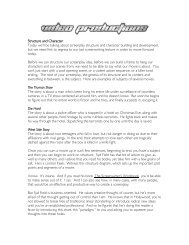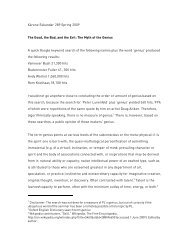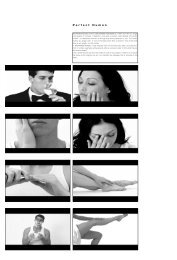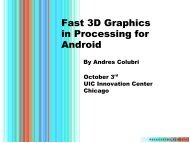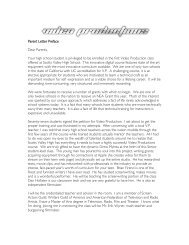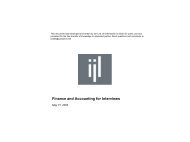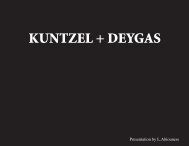UNIVERSITY OF CALIFORNIA Los Angeles - Users - UCLA
UNIVERSITY OF CALIFORNIA Los Angeles - Users - UCLA
UNIVERSITY OF CALIFORNIA Los Angeles - Users - UCLA
Create successful ePaper yourself
Turn your PDF publications into a flip-book with our unique Google optimized e-Paper software.
which has real time kinetic movement. In this thesis, I am proposing this<br />
kinetic information visualization as a new form of data visualization that<br />
can reveal and transfer data in the physical form and in real space.<br />
3.2. New Realities<br />
In contemporary society, we have to adjust to new realities (i.e. virtual,<br />
hyper, mixed, and hybrid realities) of the plethora of the mass media in<br />
contemporary urban life. With life in various realities, like Jean<br />
Baudrillard said, “the surrounding universe and our very bodies are<br />
becoming monitoring screens,” the landscape around us now unfolds as a<br />
screen. In his book, The Ecstasy of Communication, Baudrillard stated,<br />
“The landscape, the immense geographical landscape seems a vast, barren<br />
body whose very expanse is unnecessary (even off the highway it is boring<br />
to cross), from the moment that all events are concentrated in the cities,<br />
which are also being reduced to several extremely miniaturized high<br />
places.” 52<br />
In cities, people are becoming consumer-driven, and our bodies have to<br />
deal with various media screens, from the screens of TVs to those of<br />
mobile phones. However, it is impossible to judge such a media evaluation<br />
either positively or negatively. Baudrillard proposed an interesting idea<br />
about the image and screen in our modern life, which he referred to as<br />
‘hyper-reality.’ In the book Continental Philosophy, editors McNeill and<br />
Feldman describe this concept:<br />
Figure 35. Herbert Bayer,<br />
Diagram of the Field of Vision,<br />
1930<br />
[B]audrillard argued that technological existence unfolds as the<br />
presentation of simulacra, that is, of images that correspond to no<br />
underlying reality or truth, but operate as a play of signification in which it<br />
becomes increasingly impossible to identify any original or<br />
uncontaminated reality. Where reality becomes virtualized in this manner,<br />
there the virtual and the real became fused, existence has been<br />
transformed into what Baudrillard called “hyperreality”. 53<br />
52<br />
Baudrillard, Jean, The Ecstasy of Communication. Translated by Bernard and Caroline<br />
Schutze, Semiotext(e), 1988, p19<br />
53<br />
McNeill, William and Karen S. Feldman., ed., Continental Philosophy: an anthology.<br />
Blackwell, 1998. p443<br />
J.KIM_A LANDSCAPE <strong>OF</strong> EVENTS 40



